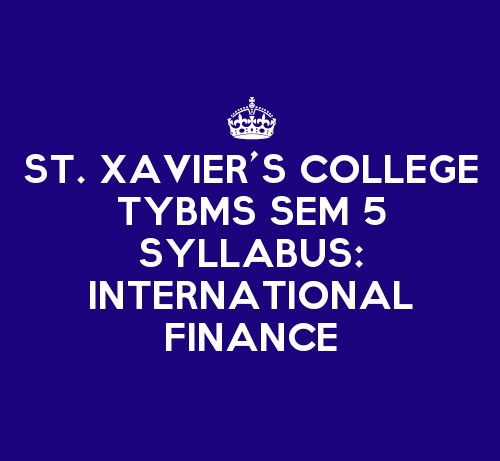International Finance subject is introduced in TYBMS at St. Xavier’s College so that students can understand the fundamentals of international finance, foreign exchange rate calculation in different market conditions and concept of risk in foreign exchange.
Unit 1: 15 lectures
Fundamentals of International Finance:
- Meaning and scope of international finance
- Balance of payments as determinant of demand for and supply of currency
- Exchange rate, determinants of / factors affecting exchange rates
- Current account deficit vs balance of trade and their implications on exchange rate.
Foreign Exchange Arithmetic I:
- Exchange rate quotations, Direct and indirect rates, cross currency rates, vehicle currency.
- % spread, calculation of cross rates
- Classification of rates in terms of settlement – cash, tom, spot and forward
- Arbitrage, Speculation and trading – spot rate arbitrage calculation.
Unit 2 – 15 lectures
Foreign Exchange Arithmetic II
- Relationship between exchange rates,
- Interest rates,
- Commodity prices – through international parity conditions namely purchasing power parity and Fisher parity
- Use of covered interest parity theory in arbitrage, borrowing and investment decisions,
- Calculation of forward rates through use of forward schedules, through use of formula, annualized forward margin, calculation of swap points – calculations for cash / tom rates to be excluded.
Exchange Rate Regimes:
- Gold Standard – Features
- Bretton Woods System – background and features, reasons for its failure, Smithsonian agreement, SDRs.
- Flexible exchange rate system – Features, managed float, Central bank intervention.
- Merits and demerits of fixed and flexible exchange rate systems
Unit 3 – 15 lectures
International Foreign Exchange Markets:
- Characteristics
- Dealing room operations
Euro Currency Market:
- Origin and reasons for the growth of euro currency (off shore) markets, their characteristics and components.
- A brief understanding of the euro-currency deposit, loans, bonds and notes market.
- Concept of off shore banking as a form of globalization of the Euro currency concept, its introduction in India, tax havens.
International Equity Markets:
- Concept of depository receipt
- Global Depository Receipt – characteristics, mechanism of issue, participants involved
- American Depository Receipt – types and characteristics
- Foreign Currency Convertible Bonds and Foreign Currency Exchangeable bonds
- Foreign Direct Investment and Foreign Portfolio Investment
- Participatory notes
Unit 4 – 15 lectures
Foreign Exchange Management in India:
- Retail and wholesale components of the Indian foreign exchange market
- Capital account convertibility
- Reserve management
- Role of FEDAI in the Indian foreign exchange market
Risk management and derivatives:
- Risk versus exposure
- Transaction, translation and economic risks faced by corporate entities
- Transaction, position, pre-settlement, settlement risks faced by commercial banks
- Internal and external hedging
- Foreign currency derivatives as instruments of risk management i.e. forward contracts, swaps, futures and options
- Overview of non-deliverable forward market (NDF market)
International Institutions:
- Contribution of bank for international settlements in risk management system
- European Central Bank
Continuous Internal Assessment:
- Mid Semester Test
- Project work – presentation
Reference Books for International Finance:
- Essential International Money – Adrian Buckley
- International finance – Adrian Buckley
- Foundations of Multinational Finance – Alan Shapiro
- Multinational Financial Management – Alan Shapiro
- A textbook of foreign trade and foreign exchange – B.K. Chaudhari, O.P. Agarwal
- A brief course in Foreign Exchange Arithmetic – C. Jeevanandam
- Foreign Exchange and Risk Management – C. Jeevanandam
- Foreign Exchange Practice, concepts and control – C. Jeevanandam
- International Finance – G. Shailaja
- International Financial management – Geert Bekaert and Robert Hodrick




42 Comments